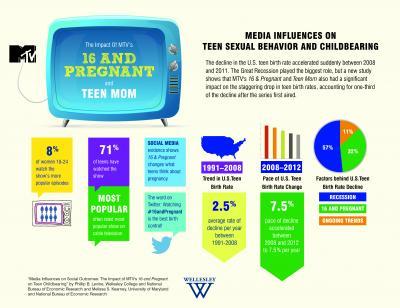Want to be a teenage mother on your way to becoming a porn star? Probably not. The Farrah Abraham career arc has helped in significantly reducing births to teens, according to a new paper.
How could that be determined? It's an economics claim so correlation-causation is not all that stringent. Wellesley College economist Phillip B. Levine and University of Maryland economist Melissa Schettini Kearney just go ahead and declare that MTV's "16 and Pregnant" and "Teen Mom" did the opposite of what social conservatives thought would happen when teen pregnancy was glorified; they say the shows significantly reduced births to teens, which means we could save billions on sex education classes and putting condoms on bananas and just encourage more reality shows.
The curves match, which is why we can also blame the Arab Spring riots on the price of steel in the mid-East if economists want. After 2009, they say, "16 and Pregnant" and "Teen Mom" can take credit for a 5.7 percent reduction in teen births, around one-third of the overall decline in teen births in the year and a half following.
Teen births were already at an historic low and dropping each year. The U.S. teen birth rate fell rapidly between 2008 and 2012 and economists blame the Great Recession for more than half of the staggering drop in the most recent, sharp decline. Then also speculate that the timing of the introduction of "16 and Pregnant" is such that it could also have contributed to the staggering drop in teen birth rates.

US teen birth rate has been in decline for decades but accelerated between 2008 and 2011. The Great Recession played the biggest role, but a new study shows that MTV's 16&Pregnant and Teen Mom also had a significant impact on the staggering drop in teen birth rates, accounting for one-third of the decline after the series first aired. Credit: Wellesley College/Soe Lin Post
Kearney and Levine investigated whether the show influenced teens' interest in contraceptive use or abortion, and whether it ultimately altered teen childbearing. "In some circles, the idea that teenagers respond to media content is a foregone conclusion, but determining whether the media images themselves cause the behavior is a very difficult empirical task," said Kearney.
To determine the show's impact on teens, Kearney and Levine analyzed several measures of exposure, including Nielsen ratings data and metrics from Google and Twitter. The researchers then examined the impact on teen birth rates using Vital Statistics Natality microdata.
Kearney and Levine found that "16 and Pregnant" and "Teen Mom" have a large and highly engaged following, win ratings wars, and lead teens to search for and tweet about the themes within. They also find that searches and tweets about birth control and abortion spike exactly when the show is on and in locations where it is more popular. According to Professor Levine, "our use of data from Google Trends and Twitter enable us to provide some gauge of what viewers are thinking about when they watch the show. We conclude that exposure to 16 and Pregnant and Teen Mom was high and that it had an influence on teens' thinking regarding birth control and abortion."
Their most important finding, though, is that "the introduction of 16 and Pregnant along with its partner shows, Teen Mom and Teen Mom 2, led teens to noticeably reduce the rate at which they give birth," according to Kearney and Levine. Their estimates imply that these shows "led to a 5.7 percent reduction in teen births that would have been conceived between June 2009, when the show began, and the end of 2010. This can explain around one-third of the total decline in teen births over that period."
Although data limitations precluded Kearney and Levine from conducting separate analyses of abortions, the researchers note that teen abortion rates also fell over this period—suggesting that the shows' impact is likely attributable to a reduction in pregnancy rather than greater use of abortion.
According to the authors, the finding that 16 and Pregnant and Teen Mom had an impact suggests that MTV drew in teens who actually were at risk of teen childbearing and conveyed to them information that led them to change their behavior, preventing them from giving birth at such a young age. "The fact that MTV knows how to make shows that teens like to watch, which speak to them in ways that resonate, presumably is critical to the show's impact," they said.
"This approach has the potential to yield large results with important social consequences," concluded Kearney and Levine. "Typically, the public concern addresses potential negative influences of media exposure, but this study finds it may have positive influences as well."
"When we developed '16 and Pregnant,' teen birth rates were reported to be on the rise, so we created this series as a cautionary tale on the hard realities of teen pregnancy. We are deeply grateful to the National Campaign to Prevent Teen and Unplanned Pregnancy for their expert guidance," said Stephen Friedman, President of MTV. "We've always believed that storytelling can be a powerful catalyst for change, and are incredibly heartened by this news."
"The entertainment media can be, and often is, a force for good," said Sarah Brown, CEO of The National Campaign to Prevent Teen and Unplanned Pregnancy. "One of the nation's great success stories of the past two decades has been the historic declines in teen pregnancy. MTV and other media outlets have undoubtedly increased attention to the risks and reality of teen pregnancy and parenthood and, as this research shows, have likely played a role in the nation's remarkable progress."






Comments